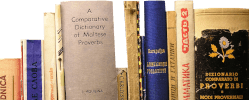
Instructions
Search in the database
In the field labeled "Proverb type" you can input text in English, a full or a partial word. Perhaps you remember the beginning of the proverb you want to find so you can try it.
By double-clicking/-tapping a row you can examine the literature references and synonymous proverbs of the proverb type in question.
The English database consists of the 'global' or nearly global types with additions from Baltic-Finnic proverb tradition and other translations.
If you compare this material to Finnish material, it is not yet as rich as it could be. The material which serves as the basis for this work is quite massive, although the basic type index is not so large.
There is the original Finnish proverb index (with additions 8,184 entries). You can also check the analysis of cultural distribution (G or FEwI etc.)
- G = global type (e.g. EAIO)
- F = Finnish or other related Baltic sea cultures
- E = European in general
- En = Northern Europe
- Ew = Western Europe including North and Latin America
- Es = Southern Europe
- Ee = Eastern Europe
- Eb = The Balkans
- A = Sub-Saharan Africa
- I = Islamic cultures
- O = older Asiatic (Orient) cultures
- P = The Pacific area
Another reason not to miss the literature references is that there has been written down a lot of variants in the main European languages including Russian (transliterations). There are also translations from Asian, Islamic and African parallels, if they belong to the universal types (705 types) or their "family" types of the total 8,300 proverb types.
The literature references (35,563 references from 350 collections or articles)
By now there are 409 books, collections or other sources.
In the broadest sense of the word "proverb type", our type system gathers together similar proverb titles from different nations into a global type having a common idea. That is why we use the practical term "universal proverb type", when we want to compare a global idea to our local proverb titles or proverb types in the narrowest sense of the word.
Every proverb type has a classification code and its own number in the database (normally beginning from 10, because of technical reasons). You can filter the displayed table by using the dropdown menu in the "Code" field. To clear the filter, select the empty entry at the top of the list.
In conjunction with most of the proverb titles (most of which here represent universal proverb types and mostly original English proverb texts) there are also neighboring proverb numbers e.g. (+ 16; 17b) or (+ the whole group) which give information about contents of the whole type cluster.
You have an opportunity to look at the literature references of neighboring proverb types, too.
If you want to refer to Kuusi’s typology, you can use the code & number combination. We will not change the original numbers.
You get more information about single types if you view the neighboring proverb types in the same sub-group and cross-references. Especially the so called ‘global proverb types’ have a common idea and never exactly same content.
A large part of Kuusi's original references are still only to be found on his original "pink cards" arranged according to our type system. Literature references are available primarily for those proverb titles, which are separated as universal proverb types and their "family members".
Search source collections by language or nation
To browse proverb materials by a certain linguistic area or translated language you can choose an area in the "Distribution" dropdown. Maybe you will have an impulse to visit the ethnological library of the Finnish Literary Society to study the M6 special collection, which lists most of the sources in the database (not available for loan).
Search the proverb types to which each collection refers
If you want to know how proverbs of some collection are dealt with in Kuusi’s typology, you may search by the abbreviation or name of the source.
Browsing the database
Kuusi’s typology consists of 13 themes and under them 52 main classes. The closest explanations for the proverb types are 325 subgroups. Each proverb type (8,300 in Finnish and until now 1721 in English) consists of more or less different proverbs in different languages having the same idea.
